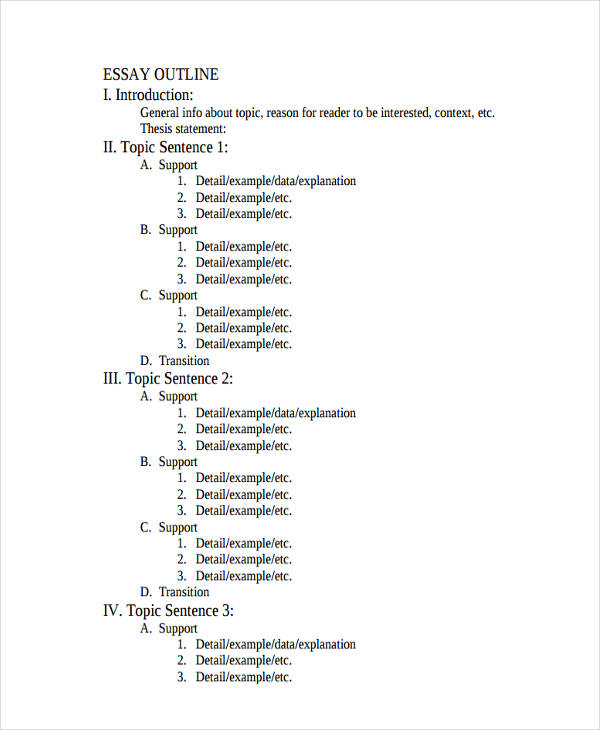
Dec 10, · To write a discussion essay, start by taking a side on the issue you're writing about, like "Immigration is good for the country." Then, outline the main points that made you decide to take that position and do research to find evidence that backs them up. Look for credible sources that can help you make your argument, and don't forget to cite Apr 10, · Narrative Format and Structure. The narrative essay format and structure are standard. Like other assignments, this type of paper normally follows a 5 paragraph essay outline: one introductory paragraph, followed by three body paragraphs, and the last narrative paragraph is the blogger.comr, unlike other types of essays, a narrative paper’s paragraphs have specifically Many organisations at the moment are working to do that. An excellent example is to collect some resume of one other working referee to know the commonest codecs in presenting their backgrounds. Academic essay writing is a mode that anybody can be taught to produce, as soon as they know the basics of writing an essay
Cause and Effect Essay Outline - Format and Samples
Last Updated: December 10, References. This article was co-authored by Jake Adams. With over 14 years of professional tutoring experience, how to do an outline for an essay, Jake is dedicated to providing his clients the very best online tutoring experience and access to a network of excellent undergraduate and graduate-level tutors from top colleges all over the nation.
Jake holds a BS in International Business and Marketing from Pepperdine University. How to do an outline for an essay are 13 references cited in this article, which how to do an outline for an essay be found at the bottom of the page.
This article has been viewedtimes. A discussion essay, also known as an argumentative essay, is one where you take a position on an issue. Start by taking a side, researching your topic, and outlining your essay before launching into the introduction and your thesis statement. Create a cohesive argument in the body of your essay, and use your conclusion to draw it all together without introducing new information.
To write a discussion essay, start by taking a side on the issue you're writing about, like how to do an outline for an essay is good for the country. Look for credible sources that can help you make your argument, and don't forget to cite them. Then, when you're writing your essay, devote 1 paragraph to each main point and include your evidence.
For help writing the introduction and conclusion to your essay, scroll down! Did this summary help you? Yes No. Log in Social login does not work in incognito and private browsers. Please log in with your username or email to continue. wikiHow Account. No account yet? Create an account. Community Dashboard Write an Article Request a New Article More Ideas Edit this Article.
Courses New Tech Skills New Get a Dating Coach New Expert Videos About wikiHow Pro Upgrade Sign In. Home Random Browse Articles Courses New About wikiHow Easy Ways to Help Approve Questions Fix Spelling Quiz App More Things to Try We use cookies to make wikiHow great. By using our site, you agree to our cookie policy. Cookie Settings. wikiHow is where trusted research and expert knowledge come together. Learn why people trust wikiHow. Download Article Explore this Article parts. Tips and Warnings.
Related Articles. Article Summary. Co-authored by Jake Adams Last Updated: December 10, References. Part 1 of Work through the question to make sure you understand it. Take the question your teacher gave you, and read through it carefully.
Look up any words and phrases you don't understand to get a better grasp of the question. Establish what the issue at hand is. With issues like the DREAM Act and President Trump's stances on policy, it's likely to remain a central issue. Using authoritative resources to back up your argument, take a stance on immigration policy, establishing whether you think it should be more or less strict and why.
They can help you better understand what they're asking for. Perform initial research to understand the issue. If you don't know much about the topic, do some reading to understand it better, starting with your textbook if it has information on the topic.
Otherwise, use the internet to research the topic for this part, making sure to choose credible sources on both sides of the issue. If your essay will be based off a discussion had in class, ask your instructor if you can use class notes as a primary source, how to do an outline for an essay. Look for respected news sources, as well as websites with ".
edu" and ". gov" extensions. You may need to look up information on the DREAM Act or President Trump's how to do an outline for an essay to help you understand the question, for example. For this part, you don't need to take extensive notes, as you're just trying to get a feel for the subject. Take a side on the issue to begin outlining your essay. After reading about both sides carefully, decide what position you want to take. Write your position at the top of a sheet of paper or at the top of a word processing document to start your outline.
If you were given a text to base your essay on, make sure that text has enough evidence to support your chosen position. Add the main points you'd like to cover to your outline. After taking a side, think about the initial reading you did. What main points persuaded you to take that position? You can use those as the main points in your paper. Write a main point by each Roman numeral. You should only cover 3 to 4 main points in a relatively short essay, such as one that's 3 to 5 pages, how to do an outline for an essay.
Find research to support your points. Now it's time to dig into your research. Head to the library or use your library's academic databases online. Find credible resources that you can use to establish your argument.
You can also use high quality news articles if they're applicable to your topic. Take notes that include citations. You can take handwritten notes or use a computer for this. As you read from relevant sources, take notes as you go along. Write the book title or article information at the top of the page, and add the page number by each section you take notes on or quote, if applicable.
For a book, you should include the author's name, the editor's name if applicablethe title of the book, the publication year, the publication city, the edition, and the title of the book chapter in an anthology by multiple authors. For a journal, include the author's name, the journal title, the article title, the digital object identifier DOIthe ISSN, the publication date, the volume if applicablethe issue if applicableand the page numbers for the journal article.
If you're searching in a database, you can often ask the database to save this information for you, but you should include identifiers on your notes. Fill in your outline to finish planning your essay. Once you've taken your notes, add bullet points underneath each main idea. Fill in points to back up the main idea, adding notes from your research. Part 2 of Begin with a hook such as a quotation or anecdote to engage readers.
A hook is the way you get a reader interested in your essay. For a discussion essay, you could use a quotation from someone whose viewpoint you agree with, for instance. For instance, you might write the following for an essay on immigration, "When I was 4-years-old, my parents told me we were going on a long trip.
After a bus ride, we spent nights walking, my dad carrying me most of the way. One day, we crossed a river. That day marked our first day in our new country.
Introduce your topic in your transition sentences. In the next few sentences, you'll move from your hook, which is broad, to your thesis statement, which is narrow. As you go, you'll bring up the main topic of your essay to give how to do an outline for an essay readers an idea of where you're headed. You should present both sides of the issue in a neutral way before stating your thesis.
Work on a thesis statement to establish your argument. After your transition sentences, you'll add your much narrower thesis statement, which tells the reader what you plan to argue. You may want to include some phrases the help the reader understand what you'll cover as your main points. Part 3 of Limit each paragraph to 1 idea. To help focus your paper, use your outline to create your paragraphs. For a short essay, you can use 1 paragraph per main idea.
If you're doing a longer essay, try writing 1 paragraph for each bullet point under the main points. If you're digging deeper, you might create a section about diversity, and then use a paragraph to cover "brings in new cuisines," another to cover "brings in new art," and so on.
Acknowledge the other side of the issue. The best way to present your argument is to discuss the other side and show how it contrasts with your position.
How to Write an Essay Outline - Tutorial, Example, Format - EssayPro
, time: 3:43A Synthesis Essay Outline: Step-By-Step Guides With Examples

Apr 10, · Narrative Format and Structure. The narrative essay format and structure are standard. Like other assignments, this type of paper normally follows a 5 paragraph essay outline: one introductory paragraph, followed by three body paragraphs, and the last narrative paragraph is the blogger.comr, unlike other types of essays, a narrative paper’s paragraphs have specifically A cause and effect essay outline is a detailed plan of action that students follow throughout the writing process. It is the key factor while writing a successful essay as it provides help in the following ways. It is used to organize thoughts logically. It makes the writing Jan 10, · The Outline. When writing a 5 paragraph essay, it is important to follow the structure. As it is said, the typical format for an essay starts with an introuction, has three body paragraphs, and sums everything up with a conclusion. Each body paragraph serves a specific purpose, and the essay should take the form of a keyhole

No comments:
Post a Comment